The Wonders of Vietnam's Rivers
Vietnam is a land of great natural beauty, with long stretches of coastline, dense forests, and rugged mountains. But perhaps the most iconic feature of this Southeast Asian country is its rich network of rivers. Vietnam's rivers form the lifeblood of the country, providing essential water resources for agriculture, transport, and tourism. From the mighty Mekong River to the peaceful Perfume River, Vietnam's waterways hold a wealth of history and culture. In this article, we'll take a journey through some of Vietnam's most remarkable rivers and explore the unique wonders they offer.
.jpg)
The Mekong River: As the 12th longest river in the world, the Mekong River stretches over 4,900 km through six countries, including Cambodia, Laos, and Vietnam. In Vietnam, the Mekong River occupies a vast delta region that supports one of the most fertile agricultural areas in the country. Take a riverboat tour or a scenic drive along the river's banks to experience the bustling floating markets, traditional villages, and stunning natural scenery. Don't miss the chance to try some of the famous Mekong Delta specialties, such as fresh coconut candy, crispy rice paper, and sweet tropical fruits.
The Red River: Running over 1,100 km from Yunnan province in China to the Gulf of Tonkin in Vietnam, the Red River is one of the most important waterways in northern Vietnam. The river valley is home to many ethnic minority communities, some of whom have lived there for centuries. You can take a boat ride along the river and visit some of these villages to learn about their unique cultural traditions, such as making pottery, weaving, or distilling rice wine. The Red River also has many scenic spots, such as the Tam Coc-Bich Dong complex, the Hoa Lu ancient capital, and the majestic Thac Ba waterfall.
.jpg)
The Perfume River: Flowing through the heart of Hue, a former imperial capital of Vietnam, the Perfume River is a symbol of the city's romantic beauty and historical significance. The river is named after a myth that says the fragrance of flowers falling into the waters at upstream can be smelled downstream in Hue city. The best way to explore the Perfume River is to take a traditional dragon boat ride, which will take you to visit many famous landmarks such as the Thien Mu pagoda, the Hon Chen temple, and the imposing Hue citadel. You can also sample some of the delicious local dishes, such as bun bo Hue (spicy beef noodle soup) or banh beo (steamed rice cakes with shrimp).
The Cai River: This small river runs through the charming countryside of Hoi An, a UNESCO World Heritage site renowned for its well-preserved ancient architecture and traditional culture. A cycling or motorbike tour along the Cai River will take you through lush rice paddies, rustic fishing villages, and colorful herb gardens. You can also participate in some local activities such as rowing a coracle basket boat, fishing with the traditional net, or making a lantern from bamboo and silk. Don't forget to savor some of the delicious local specialties, such as cao lau (rice noodle soup with pork and herbs) or banh mi (Vietnamese baguette sandwich).
.jpg)
The Thu Bon River: Like the Cai River, the Thu Bon River flows through Hoi An and provides a tranquil backdrop to the town's romantic ambiance. The river has played a vital role in Hoi An's history as a major trading port during the 16th and 17th centuries. A sunset boat ride on the Thu Bon River is a must-do experience, as it will give you a stunning panoramic view of the Hoi An old town and the surrounding countryside. You can also witness the local fishermen casting their nets or lighting up the night sky with colorful lanterns. The Thu Bon River also offers plenty of culinary delights, such as the famous white rose dumplings or the mackerel with rice paper.
Conclusion:
Vietnam's rivers are much more than just a source of water or transportation. They are a reflection of the country's rich culture, history, and natural beauty. Each river has its unique charm and character, offering a diverse array of experiences for travelers to explore. Whether you're cruising on the Mekong, cycling along the Cai, or drifting on the Perfume, you'll be immersed in the authentic and enchanting world of Vietnam's rivers. Come and discover the wonders of the "S-shaped land" through its life-giving rivers.







